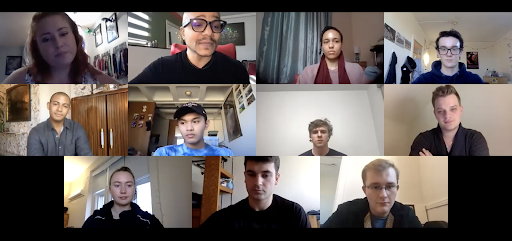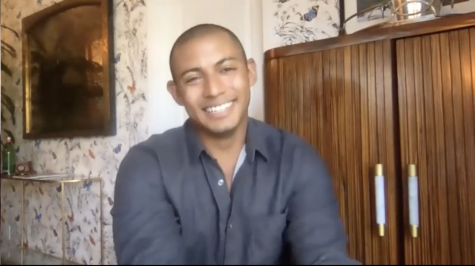Zach Stafford discusses queerness, dogs in ‘Green Room’ talk
March 31, 2021

“I am so excited to be here talking to you creative folks,” Zach Stafford, a journalist and former editor-in-chief of The Advocate who focuses on queer culture, said during the most recent talk in the College’s “Green Room” series. “I love talking to creative people.” At the March 13 event, Stafford joined a group of students to discuss his journalism career, the intersectional obstacles he has faced, and — importantly — the loving power of a good pet dog.
Last fall, Chair of the Theatre Department Omar Sangare began a new program called “The Green Room: a peaceful space for progressive minds.” This series of lectures and conversations consists of one-hour “episodes” with leaders in the arts industries, giving students a chance for mentorship and inspiration. The lectures feature guests with diverse viewpoints, backgrounds, and experiences, and include renowned directors, producers, journalists, actors, and designers. Sangare introduced Stafford’s “dog talk” session by showing students his dog and noting the importance of friends and support during difficult times, as his dog Salif is to him. “We learn from our new friends, our special guests,” Sangare said.
Two years ago, Stafford was named editor-in-chief of The Advocate, the oldest continuously published LGBTQ+ periodical in the world. Prior to that position, he was the founding editor-in-chief of INTO, the LGBTQ+ digital magazine that quickly became one of the most-read queer outlets in the world, and he also worked as the CCO of Grindr. Stafford opened by recounting the beginnings of his career. “How I became a journalist, or editor, wasn’t planned,” he said. In graduate school, Stafford started blogging. He built a following, and before he knew it, he had a column with the Chicago Tribune. Stafford explained that he began his journey in college. “I was fighting with celebrities on Twitter about things I blogged about,” Stafford said.
As he became more involved in the world of journalism, he began to recognize its problems with representation. “I really wanted to see myself in the media around me,” he said. “I know a lot of us have that expectation or desire.” Stafford talked about living in a “white, straight and heteronormative [world] … and I was a Black queer boy from the South.” And when Stafford started telling his own story, he came to realize the power in helping other people tell theirs. “Journalism is reaching people who may be voiceless or may not be seen, and helping them be seen,” he said.
Stafford began writing his book Boys: An Anthology in 2014 when he met a doctor who explained how his dog finally taught him that he was worthy of love after testing HIV-positive. The book is a compilation of essays that showcase stories and experiences of gay, queer and trans* men, and many of these essays focus on the relationship between HIV-positive individuals and their pet dogs. Stafford started some research and learned that “over 100,000 people in America were HIV-positive and also had dogs.” Stafford soon discovered that because people who tested HIV-positive often felt so alone and ashamed, dogs “became a vehicle for them to learn that they don’t deserve to feel shame and that they do deserve to be loved.”
Although this research began as an art project for Stafford, it evolved into writing, and became a way for him to bring attention to the “very real systems” of oppression, racism, and homophobia that entangle HIV-positive individuals. The work started as a traveling gallery show that displayed HIV-positive dog owners and their stories, and soon gained a large following.
Stafford realized that he had a unique way to bring attention to issues surrounding HIV. “Dogs became a really great way to sneak a story in, because people at first think ‘Oh a dog!’ and then by the end of reading, they think ‘Oh wow, now I am thinking about the housing crisis in South-Central LA, through this dog named Coconut,’” he said. Eventually, the project became the book Boys: An Anthology, with the proceeds from sales going to clinics around the world that help support HIV-positive kids.
“I wanted people to know that these people are alive and that they are so alive that they sat down to do this portrait,” Stafford said. “It’s so cliché, but I wanted to show that love can just do anything.” For Stafford’s work, the love of a dog transforms the stories of HIV-positive individuals.

For a few years, Stafford’s journalism also focused on hate crimes, and he worked specifically with family members who lost loved ones to homicide. “I was really interested in this idea that — and I say this as a queer Black person — that as people we can hate ourselves so much that we will hurt someone that looks like you or your truth,” he said. Stafford acknowledged that many hate crimes “deal with people that are in the closet,” and he talked about the importance of “the labor of trying to love yourself and who gets hurt in that process.”
“When you’re talking to the mother that lost her child, how she talks about her child, how she constructs narrative, for me is truth,” he added.
Stafford learned of the necessity of patience in his work with dog owners. “At first [everyone] didn’t really get it, but good stories need time to breathe and live a little,” Stafford said. “The best advice I can give is that sometimes you’re doing a disservice to a work by rushing it — give it time to breathe, and give yourself time to breathe and live in it. If your body isn’t ready to tell a story, then take a break.”
When asked by a student about how he maintained motivation and didn’t fall into traps of more instant gratification with his work, Stafford explained that there were lots of moments where he wanted to stop. “I had a point of time in my life where I had to go to my collaborators and say it’s just too much, I just can’t do this with everything else,” he said. “But instead of giving up, I asked for help… You can self-sabotage stories and projects if you release them too soon, or if you release them for the wrong reasons.”
Stafford’s book is being developed into a television show called When Dogs Heal. “It will kind of be like Queer-Eye, but with dogs,” he said. Stafford ended with advice on perspective. “The truth can change just based on how you look at one thing, and that is such a cool thing for storytellers to know,” he said. “It is what we do here as artists that tell stories on stage, in writing, in a photo. All art is just a story in a different manifestation.”
Stafford’s session, with a special guest appearance from Sangare’s dog Salif, along with all previous “The Green Room” sessions, are available to view on the Williams Theatre page. Through the rest of this spring semester, more activists, directors, singers, and performers will be telling their stories with Williams’ students in these “The Green Room” talks. The Green Room offers Williams an unprecedented opportunity to hear the voices and perspectives of prominent progressive minds. “We all have something to talk about, we all have a story to tell,” Stafford said. “Telling a story is as human as breathing.”








